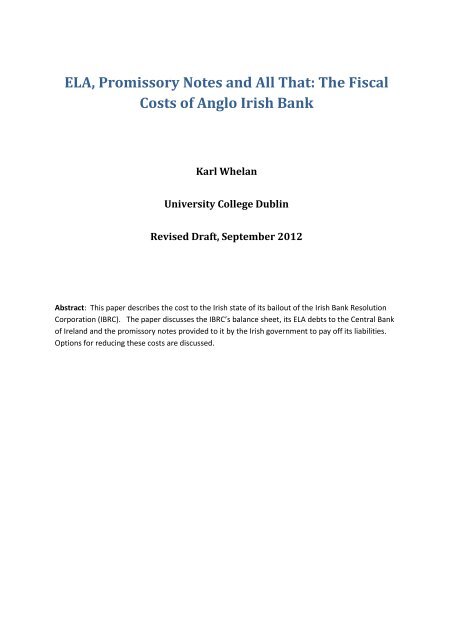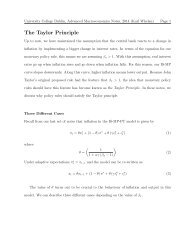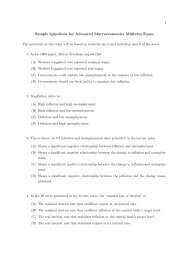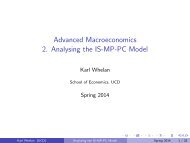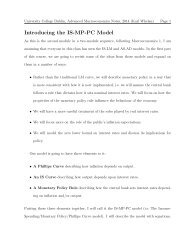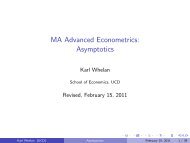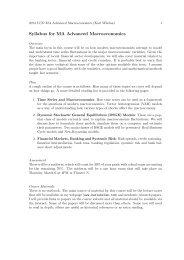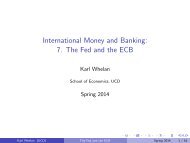ELA, Promissory Notes and All That: The Fiscal Costs ... - Karl Whelan
ELA, Promissory Notes and All That: The Fiscal Costs ... - Karl Whelan
ELA, Promissory Notes and All That: The Fiscal Costs ... - Karl Whelan
You also want an ePaper? Increase the reach of your titles
YUMPU automatically turns print PDFs into web optimized ePapers that Google loves.
<strong>ELA</strong>, <strong>Promissory</strong> <strong>Notes</strong> <strong>and</strong> <strong>All</strong> <strong>That</strong>: <strong>The</strong> <strong>Fiscal</strong><br />
<strong>Costs</strong> of Anglo Irish Bank<br />
<strong>Karl</strong> <strong>Whelan</strong><br />
University College Dublin<br />
Revised Draft, September 2012<br />
Abstract: This paper describes the cost to the Irish state of its bailout of the Irish Bank Resolution<br />
Corporation (IBRC). <strong>The</strong> paper discusses the IBRC’s balance sheet, its <strong>ELA</strong> debts to the Central Bank<br />
of Irel<strong>and</strong> <strong>and</strong> the promissory notes provided to it by the Irish government to pay off its liabilities.<br />
Options for reducing these costs are discussed.
1. Introduction<br />
<strong>The</strong> Irish state has committed an extraordinary €64 billion—about 40 percent of GDP—towards<br />
bailing out its banking sector. €30 billion of this commitment has gone towards acquiring almost<br />
complete ownership of <strong>All</strong>ied Irish Banks <strong>and</strong> Irish Life <strong>and</strong> Permanent <strong>and</strong> partial ownership of Bank<br />
of Irel<strong>and</strong>. 1 It is possible that some fraction of this outlay may be recouped at some point in the<br />
future via sales of these shares to the private sector. In contrast, the remaining €35 billion that<br />
relates to Irish Bank Resolution Corporation (IBRC), the entity that has merged Anglo Irish Bank <strong>and</strong><br />
Irish Nationwide Building Society, is almost all “dead money” that will never be returned to the<br />
state.<br />
Much of the commentary on Irel<strong>and</strong>’s bank bailout has focused on the idea that the Irish<br />
government should change its policy in relation to payment of unsecured IBRC bondholders.<br />
However, the amount of IBRC bondholders remaining is small when compared with the total cost of<br />
bailing out these institutions. Instead, the major debt burden due to the IBRC relates to promissory<br />
notes provided to it by the Irish government, which in turn are largely being used to pay off so-called<br />
Exceptional Liquidity Assistance (<strong>ELA</strong>) loans that have been provided by the Central Bank of Irel<strong>and</strong>.<br />
This paper discusses the fiscal costs of the IBRC bailout focusing in particular on the institution’s <strong>ELA</strong><br />
debts <strong>and</strong> the promissory notes being used to repay them. <strong>The</strong> paper explains how a number of<br />
aspects of the IBRC bailout differ somewhat from how they have been described by the media.<br />
Despite a lot of media focus on the interest rate on the promissory notes, I explain how the interest<br />
rate on these notes has no long-run impact on Irish public debt. In addition, the official promissory<br />
note schedule is unlikely to be stuck to as the IBRC will likely be wound up once its <strong>ELA</strong> is paid off.<br />
Finally, in light of the Eurosummit statement of June 29, 2012 suggesting the potential for a<br />
restructuring of Irel<strong>and</strong>’s bank-related debt, I discuss the range of policy options available for<br />
reducing the cost of the IBRC bailout.<br />
<strong>The</strong> paper is organised as follows. Section 2 discusses the balance sheet of the IBRC <strong>and</strong> the crucial<br />
role played by its <strong>ELA</strong> debts. Section 3 describes the process of granting <strong>and</strong> repayment of <strong>ELA</strong> <strong>and</strong><br />
the role of the ECB in this process. Section 4 discusses the IBRC’s promissory notes <strong>and</strong> their effect<br />
on official debt <strong>and</strong> deficits. Section 5 then examines some potential policy options.<br />
2. <strong>The</strong> IBRC’s Balance Sheet<br />
<strong>The</strong> IBRC was formed on July 1 st 2011 by a merger of Anglo Irish Bank <strong>and</strong> Irish Nationwide Building<br />
Society (INBS) both of which were being wound down after huge losses on property loans. Table 1<br />
illustrates how the liability side of the combined IBRC balance sheet evolved over the past few years.<br />
At the end of 2007, Anglo had €58 billion in deposits <strong>and</strong> €24 billion in funding from debt securities<br />
while INBS had €7 billion in deposits as well as €7 billion in debt securities. <strong>The</strong> subsequent years,<br />
amid financial crisis <strong>and</strong> nationalisation of the banks, saw the vast majority of these deposits pulled<br />
1 <strong>The</strong> source of the figures on the cost of the bank bailout is a written parliamentary answer from Minister for<br />
Finance, Michael Noonan (available at http://debates.oireachtas.ie/dail/2012/04/18/00157.asp) updated to<br />
take into account the €1.3 billion spent in June 2012 on acquiring Irish Life from what had been Irish Life <strong>and</strong><br />
Permanent.<br />
1
<strong>and</strong> moved out of Irel<strong>and</strong> while the institutions were unable to issue any new debt securities.<br />
Combined funding from deposits <strong>and</strong> debt securities fell from €96 billion at the end of 2007 to €23<br />
billion at the end of 2010.<br />
Some of the funds to pay off depositors <strong>and</strong> bond-holders over this period came from selling assets<br />
<strong>and</strong> from loan repayments but most came from borrowing from central banks. At first, most of this<br />
borrowing took the form of st<strong>and</strong>ard Eurosystem refinancing operations. However, these operations<br />
require counterparties to pledge particular types of collateral <strong>and</strong> Anglo began to run out of eligible<br />
collateral as the Irish banking crisis began in late 2008.<br />
In March 2009, the Central Bank of Irel<strong>and</strong> agreed to provide Anglo with €11.5 billion in so-called<br />
“Exceptional Liquidity Assistance” (<strong>ELA</strong>) loans against collateral that did not qualify for st<strong>and</strong>ard<br />
Eurosystem monetary operations. As the crisis intensified through 2010, <strong>ELA</strong> borrowings ramped up<br />
significantly. By the end of 2010, the IBRC institutions owed €24.3 billion in Eurosystem borrowings<br />
<strong>and</strong> had €28.1 billion in <strong>ELA</strong> debts to the Central Bank of Irel<strong>and</strong>.<br />
During the first half of 2011, the IBRC institutions transferred almost all of their remaining deposits<br />
to other Irish banks along with their holdings of about €16 billion in senior bonds that had been<br />
issued to them by NAMA. Because the NAMA bonds had been used as collateral for Eurosystem<br />
borrowings, the IBRC had to pay off most of its ECB loans, which further increased its dependence on<br />
<strong>ELA</strong> from the Central Bank of Irel<strong>and</strong>. By the end of 2011, Anglo owed €40 billion in <strong>ELA</strong> <strong>and</strong> had<br />
Eurosystem borrowings of only €2 billion.<br />
Table 2 shows the IBRC’s balance sheet as of the end of 2011. By this point, deposits were a tiny part<br />
of the organisation’s liabilities, while debt securities outst<strong>and</strong>ing were down to €6.3 billion, about<br />
twelve percent of total liabilities. <strong>The</strong> vast majority of the IBRC’s debts—€42.2 billion of a total of<br />
€52.3 billion—are owed to central banks <strong>and</strong> the vast majority of these take the form of <strong>ELA</strong>.<br />
<strong>The</strong>re has been a considerable focus on payments to unguaranteed senior IBRC bondholders.<br />
However, by the end of 2011, most of the IBRC’s €6.3 billion in outst<strong>and</strong>ing debt securities were<br />
guaranteed by the Irish government. <strong>The</strong>re have also been some repayments during 2012 on<br />
unguaranteed bonds, including a €1.25 billion Anglo bond that was paid out in January 2012. As a<br />
result of these payments, unguaranteed unsecured senior bonds now account for less than €1 billion<br />
of the IBRC’s debts.<br />
<strong>The</strong> left-h<strong>and</strong>-side of Table 2 explains where the IBRC is to get the resources to pay off its liabilities<br />
as it winds down. It has two principal types of assets. First, there are loans to customers. Second,<br />
there are a series of promissory notes from the Irish government that were provided to Anglo <strong>and</strong><br />
INBS during 2010. <strong>The</strong>se promissory notes were valued on the IBRC’s balance sheet at end-2011 at<br />
€29.9 billion <strong>and</strong> (as will be discussed later) are currently scheduled to provide a series of payments<br />
over the next 20 years.<br />
A key message from the balance sheet is that, without the promissory notes, the IBRC would still<br />
have sufficient assets to pay off all of its deposits, its bondholders, its Eurosystem borrowings <strong>and</strong> all<br />
2
of its other debts apart from <strong>ELA</strong>. But only €10 billion of the €40 billion <strong>ELA</strong> debts could be paid off if<br />
the bank did not have the promissory notes. So, effectively, the promissory notes exist to pay off<br />
the <strong>ELA</strong> debts to the Central Bank of Irel<strong>and</strong>.<br />
Table 1: <strong>The</strong> IBRC’s Liabilities (Billions of Euros)<br />
End-2007 End-2010 End-2011<br />
Total Liabilities 107.2 80.8 52.3<br />
Of Which:<br />
Deposits 65.8 15.9 1.0<br />
Debt Securities 30.3 7.5 6.3<br />
Subordinated Debt 5.6 0.7 0.5<br />
Other Liabilities 5.4 4.3 3.2<br />
Eurosystem<br />
Borrowings<br />
0.0 24.3 2.1<br />
<strong>ELA</strong> Debts to CBI 0.0 28.1 40.1<br />
Table 2: IBRC Balance Sheet at End-2011 (Billions of Euros)<br />
Assets Liabilities <strong>and</strong> Equity<br />
<strong>Promissory</strong> <strong>Notes</strong> 29.9 Deposits 0.6<br />
Loans 20.0 Debt Securities 5.4<br />
Other 5.6 Subordinated Debt 0.5<br />
Other Liabilities 3.6<br />
Eurosystem borrowings 2.1<br />
<strong>ELA</strong> Debts to Central Bank 40.1<br />
Equity 3.2<br />
Total 55.5 Total 55.5<br />
3
3. <strong>The</strong> ABCs of <strong>ELA</strong><br />
This section discusses the process by which Exceptional Liquidity Assistance is issued <strong>and</strong> moves on<br />
to the various legal <strong>and</strong> accounting issue related to the issuance <strong>and</strong> repayment of <strong>ELA</strong> <strong>and</strong> the cost<br />
of this repayment to the Irish state.<br />
3.1. Central Bank Balance Sheets <strong>and</strong> Collateral Frameworks<br />
<strong>The</strong> national central banks (NCBs) in the euro area each report a monthly balance sheet. A stylised<br />
central bank balance sheet is produced below. On the left-h<strong>and</strong>-side, it describes the current value<br />
of the assets the central bank has acquired via money creation. <strong>The</strong> right-h<strong>and</strong>-side shows the<br />
amount of money the central bank has created over time as well as the residual value by which the<br />
value of the bank’s assets exceeds the money created, which is termed the central bank’s capital.<br />
<strong>The</strong> right-h<strong>and</strong>-side of the balance sheet is often described as illustrating the central bank’s<br />
liabilities. However, it is worth stressing that a central bank’s liabilities are quite different from those<br />
of any private entity. A central bank that prints a fiat currency that people wish to use for<br />
transactions can never go out of business. A central bank with negative capital could be labelled as<br />
“insolvent” in some technical sense. However, this is not an insolvency that corresponds to any<br />
private sector version of this concept. As long as the bank can create money that people wish to use,<br />
it can pay off any debts that fall due <strong>and</strong> honour all of its obligations.<br />
<strong>That</strong> said, the ability to create money is an extremely powerful tool <strong>and</strong> should be carefully<br />
monitored. In particular, within a common currency area, it is particularly important that each<br />
participating member state is not seen to be particularly responsible for fuelling inflation by abusing<br />
its power to create money. An example of such an abuse is making loans to insolvent banks. To<br />
prevent such abuses, the Eurosystem’s refinancing operations take the form of repurchase<br />
agreements designed to prevent losses on money creating operations.<br />
A Stylized Eurosystem Central Bank Balance Sheet<br />
Assets Liabilities<br />
Assets acquired by making loans <strong>and</strong><br />
buying securities<br />
Central Bank Capital<br />
Some other assets Money created by making loans <strong>and</strong><br />
buying securities<br />
Of which:<br />
Reserve Accounts<br />
Bank <strong>Notes</strong><br />
Intra-Eurosystem Liabilities<br />
4
<strong>The</strong> Eurosystem’s repurchase agreements involve banks pledging financial assets to their local NCB<br />
as collateral in return for loans, with the terms of these loans set by the ECB’s Governing Council.<br />
Haircuts are applied to the collateral, meaning the amount that is loaned to the borrowing bank is<br />
less than the value of the asset, with the amount that can be loaned increasing with the quality of<br />
the collateral. 2 Should a bank default on its loans from an NCB, the collateral framework is intended<br />
to see the NCB still left with an asset that has at least the same value as the loan.<br />
<strong>That</strong> said, no risk-control framework can completely rule out losses on monetary operations. <strong>The</strong><br />
legal statute governing the Eurosystem is quite vague about the implications for an NCB of losses<br />
incurred in monetary operations. However, in practice, the Governing Council of the ECB used the<br />
defaults by Lehmans <strong>and</strong> other banks in 2008 to clarify in a statement in March 2009 that losses<br />
should be shared in full by the Eurosystem NCBs in proportion to their ECB capital key shares. 3<br />
This raises the question of what would happen should a Eurosystem central bank have its capital<br />
eliminated by losses on operations. Perhaps surprisingly, as far as I can tell, the legal structures<br />
underpinning the Eurosystem don’t discuss this eventuality. However, it is generally understood that<br />
NCBs would need to be “recapitalised” by fiscal transfers from their national government.<br />
3.2. <strong>ELA</strong> <strong>and</strong> the ECB Governing Council<br />
<strong>The</strong> Eurosystem allows for a broad range of assets to be pledged as collateral in its refinancing<br />
operations. However, Anglo Irish Bank began to run out of eligible collateral in early 2010 <strong>and</strong> would<br />
have defaulted on bonds or failed to honour deposit withdrawals without access to alternative<br />
funding. <strong>That</strong> funding took the form of <strong>ELA</strong> loans from the Central Bank of Irel<strong>and</strong>. <strong>The</strong>se loans are<br />
provided against collateral or commitments that are not accepted in st<strong>and</strong>ard Eurosystem<br />
operations <strong>and</strong> any losses on these loans fall directly on the ECB, i.e. the usual loss-sharing<br />
arrangements are not applied if a bank fails to repay <strong>ELA</strong>.<br />
<strong>The</strong> Central Bank’s power to issue <strong>ELA</strong> comes from Irish law. <strong>The</strong> Central Bank Act provides it with a<br />
general power to lend against security to credit institutions <strong>and</strong> also provides it with an explicit<br />
financial stability objective which can justify exceptional loans to prevent banks from failing.<br />
This does not mean, however, that the Central Bank has complete freedom to operate its <strong>ELA</strong><br />
programs however it wishes. <strong>The</strong> Eurosystem has reporting procedures in place for <strong>ELA</strong> so the ECB<br />
can assess the effect of these operations on aggregate liquidity in the Euro area <strong>and</strong> the ECB has<br />
substantial control over the activities of NCBs. 4 Article 14.3 of Protocol on the Statute of the<br />
European System of Central Banks <strong>and</strong> of the European Central Bank states that NCBs “shall act in<br />
accordance with the guidelines <strong>and</strong> instructions of the ECB” while Article 14.4 states “National<br />
central banks may perform functions other than those specified in this Statute unless the Governing<br />
Council finds, by a majority of two thirds of the votes cast, that these interfere with the objectives<br />
<strong>and</strong> tasks of the ESCB.” 5<br />
2<br />
See European Central Bank (2011) for a detailed discussion of the operational framework for monetary policy<br />
in the Euro area.<br />
3<br />
See press release here www.ecb.int/press/pr/date/2009/html/pr090305_2.en.html.<br />
4 See ECB (2007).<br />
5 See www.ecb.int/ecb/legal/pdf/en_statute_2.pdf<br />
5
<strong>The</strong>se rules mean that the ECB must be consulted when <strong>ELA</strong> is issued <strong>and</strong> it will assess whether the<br />
issuance of <strong>ELA</strong> interferes with its monetary policy stance. <strong>The</strong> Governing Council can vote at any<br />
time by a two-thirds majority to stop any <strong>ELA</strong> programme. In addition, the ECB views loans to<br />
insolvent credit institutions <strong>and</strong> non-temporary liquidity support programmes as a violation of the<br />
clause prohibiting monetary financing in the European treaty. 6<br />
For these reasons, the ECB has been heavily involved in the design of Irel<strong>and</strong>’s <strong>ELA</strong> programme. It is<br />
likely that ECB approval was required in relation to the payment structure of the promissory notes<br />
which provide the funds with which <strong>ELA</strong> will be repaid. In addition, the ECB sought various<br />
assurances that <strong>ELA</strong> would be repaid such as “letters of comfort” sent from the Irish Minister for<br />
Finance to the Governor of the Central Bank on each occasion a new <strong>ELA</strong> programme was initiated<br />
indicating the intention that the <strong>ELA</strong> would be repaid <strong>and</strong> the provision of so-called “facility deeds”<br />
which the Central Bank annual reports describe as providing a government guarantee in relation to<br />
repayment of <strong>ELA</strong>. 7<br />
In practice, it appears that <strong>ELA</strong> credit is provided to banks over a very short maturity (a couple of<br />
weeks) <strong>and</strong> the ECB’s Governing Council regularly considers whether to stop the programme. In<br />
addition, the ECB’s view on the need for solvency of institutions in receipt of <strong>ELA</strong> means that most<br />
likely they must approve of any restructuring of the assets of such a bank, such as a change in the<br />
terms of the IBRC’s promissory note.<br />
3.3. Issuance <strong>and</strong> Repayment of <strong>ELA</strong> <strong>and</strong> Intra-Eurosystem Balances<br />
In explaining what happens when <strong>ELA</strong> is issued <strong>and</strong> subsequently repaid, it is helpful to explain the<br />
three subcomponents listed under “money created” in the stylised central bank balance sheet.<br />
Intra-Eurosystem Balances<br />
<strong>The</strong> first entry is “reserves”. Every bank in the Eurosystem maintains a reserve account with its<br />
national central bank. When a bank obtains a loan as part of either a Eurosystem refinancing<br />
operations or <strong>ELA</strong>, it receives a credit to this reserve account. This is textbook money creation in<br />
which money is conjured out of thin air. <strong>The</strong> second entry is “bank notes”. When a bank requests<br />
cash to use in ATM machines, its reserve account with the central bank is deducted <strong>and</strong> the “bank<br />
notes in circulation” entry on the central bank’s balance sheet is adjusted upwards.<br />
<strong>The</strong> third entry, Intra-Eurosystem liabilities, is more complex. If an Irish bank requests that money be<br />
transferred to another Irish bank, then the Central Bank simply debits one reserve account <strong>and</strong><br />
credits another. Suppose, however, an Irish bank wants to transfer money to a German bank. This<br />
leads to a reduction in the Irish bank’s reserve account <strong>and</strong> increase in the receiving bank’s account<br />
with the Bundesbank. This implies a decline in the Central Bank of Irel<strong>and</strong>’s liabilities <strong>and</strong> an<br />
increase in the Bundesbank’s liabilities.<br />
To keep the central bank capital of both central banks unchanged as a result of this transaction, the<br />
Eurosystem’s Target2 payments system increases the Central Bank of Irel<strong>and</strong>’s Intra-Eurosystem<br />
6 See page 24 of ECB (2008).<br />
7 Copies of most of the letters of comfort, which were obtained via a Freedom of Information request by RTE,<br />
are available at www.rte.ie/news/2011/0718/centralbank-business.htm.<br />
6
liability (or reduces its equivalent asset if it is in credit with the Eurosystem) <strong>and</strong> also the increases<br />
the Bundesbank’s Intra-Eurosystem asset (or reduces its liability). <strong>The</strong>se Intra-Eurosystem balances<br />
average to zero. Those countries with Intra-Eurosystem liabilities pay interest on these liabilities at<br />
the rate of the Eurosystem’s main refinancing rate (currently 1 per cent). This interest is<br />
accumulated at the ECB <strong>and</strong> redistributed to those countries with Intra-Eurosystem credits.<br />
<strong>ELA</strong> Issuance <strong>and</strong> Repayment<br />
We can now describe how the Central Bank’s balance sheet changes when it issues <strong>ELA</strong> to Irish banks<br />
to allow foreign bondholders <strong>and</strong> depositors to be repaid. <strong>The</strong> receiving bank receives a credit to its<br />
reserve account <strong>and</strong> then requests to transfer funds to a foreign deposit account. This leads to an<br />
increase in the Central Bank’s Intra-Eurosystem liabilities.<br />
What occurs when <strong>ELA</strong> principal is repaid by the IBRC? <strong>The</strong>re are two potential scenarios. In the first,<br />
the Central Bank of Irel<strong>and</strong> maintains its balance sheet size exactly as before <strong>and</strong> simply adds to its<br />
stock of assets; for example, they could purchase gold or securities. Profits from these investments<br />
could eventually be returned to the Irish state.<br />
In the second scenario, the Central Bank does not acquire any new assets but simply reduces the size<br />
of its balance sheet, marking down both the value of its <strong>ELA</strong> asset <strong>and</strong> the value of its liabilities. This<br />
is the scenario that actually occurs. <strong>The</strong> Central Bank writes down its assets <strong>and</strong> while its Intra-<br />
Eurosystem liabilities increase when <strong>ELA</strong> is issued, this entry declines when <strong>ELA</strong> is repaid.<br />
<strong>The</strong> effect of <strong>ELA</strong> repayment on the Central Bank’s balance sheet can be seen from the repayments<br />
made by the non-IBRC banks over the past year, all of whom have repaid their <strong>ELA</strong> loans. <strong>The</strong> “Other<br />
Assets“ category that is nearly completely accounted for by <strong>ELA</strong> declined from €70 billion in February<br />
2011 to €45 billion in March 2012 <strong>and</strong> regular Eurosystem lending declined from €117 billion to €85<br />
billion. This lead to a €52 billion decline in the size of the Central Bank balance sheet over this<br />
period, with €44 billion of this corresponding to a decline in “Other Liabilities”, the category that<br />
contains intra-Eurosystem liabilities.<br />
I would note however, that it is hardly correct to say as Minister for Finance Michael Noonan has,<br />
that “<strong>ELA</strong> is itself funded by the CBI through Intra-Eurosystem liabilities”. 8 This suggests that the<br />
appearance of an <strong>ELA</strong> asset on the Central Bank of Irel<strong>and</strong>’s balance sheet is directly accompanied by<br />
an increase in Intra-Eurosystem liabilities. However, at the moment of “conception” of the <strong>ELA</strong>, the<br />
corresponding increase in liabilities is a credit to the reserve account of the bank receiving the <strong>ELA</strong><br />
loans. Only if that bank then uses its <strong>ELA</strong> funds to transfer money to bank accounts outside Irel<strong>and</strong><br />
does the Central Bank of Irel<strong>and</strong>’s balance sheet start to show an increase in Intra-Eurosystem<br />
liabilities. Suggestions that <strong>ELA</strong> funds are “borrowed by the Central Bank of Irel<strong>and</strong> from the ECB”<br />
are even further off the mark.<br />
Interest Payments on <strong>ELA</strong> <strong>and</strong> Funding Cost to the State<br />
<strong>The</strong> Central Bank has not commented publicly on the interest rate it charges on <strong>ELA</strong>. However, the<br />
its 2011 annual report shows €1.63 billion in earnings from <strong>ELA</strong> interest, while its monthly balance<br />
sheets figures suggest an average value for <strong>ELA</strong> of €52 billion. This suggests an average interest rate<br />
8 See www.kildarestreet.com/wrans/?id=2012-01-31.767.0&s=mathews#g774.0.q<br />
7
of slightly over 3 percent for 2011. Anglo Irish Bank’s recent reports have noted that the interest rate<br />
on its <strong>ELA</strong> loans is linked to the ECB marginal lending facility which is 75 basis points higher than the<br />
main refinancing rate <strong>and</strong> averaged 2 percent in 2011. So my guess is that the formula used to<br />
determine the <strong>ELA</strong> interest rate is something like “marginal lending facility plus 100 basis points.”<br />
<strong>The</strong> Central Bank currently pays out interest of 0.75 percent on money held in its reserve accounts<br />
<strong>and</strong> on Intra-Eurosystem liabilities, so this raises the question of what happens to the profits<br />
obtained via the spread charged on <strong>ELA</strong>. Profits relating to Eurosystem monetary policy operations<br />
are shared among the various national central banks. However, this is not the case for profits<br />
associated with <strong>ELA</strong> operations. <strong>The</strong> Central Bank’s 2011 income on <strong>ELA</strong> contributed to a €1.2 billion<br />
profit, of which €958 million was returned to the Exchequer.<br />
So what is the ultimate cost to the state of the IBRC having to repay its <strong>ELA</strong>? Because the payment of<br />
money by the Irish Exchequer to IBRC <strong>and</strong> the repayment of <strong>ELA</strong> to the Central Bank are both<br />
transactions involving arms of the Irish states, some have concluded that these transactions are<br />
completely circular <strong>and</strong> thus have no net cost to the state.<br />
<strong>The</strong> reality is more subtle <strong>and</strong> less attractive. When the IBRC repays its <strong>ELA</strong> debts, the money that<br />
had been created is simply taken out of circulation. <strong>The</strong> only benefit to the Irish state is the<br />
reduction in interest payments on Central Bank’s intra-Eurosystem liabilities. This can boost its<br />
profits which can be returned to the Exchequer. However, the cost to the Central Bank of the intra-<br />
Eurosystem liabilities is very low, currently only 0.75 percent, <strong>and</strong> there are no requirements that<br />
the principal be repaid according to any set timeline. In contrast, the future costs of funding to the<br />
state involved in obtaining the money to repay the <strong>ELA</strong> are likely to be much higher. Effectively,<br />
repayment of <strong>ELA</strong> by the IBRC is equivalent to the state borrowing money at expensive terms to<br />
gradually repay a low-cost interest-only perpetual loan.<br />
4. <strong>Promissory</strong> <strong>Notes</strong><br />
This section discusses a number of issues relating to the promissory notes provided to the IBRC.<br />
4.1. Payment Structure<br />
During 2010, it became apparent that Anglo <strong>and</strong> Irish Nationwide had two serious problems. <strong>The</strong><br />
first was a liquidity problem; both institutions were losing deposits <strong>and</strong> had no access to<br />
international bond markets. In addition, there was a solvency problem, as it became clear that both<br />
institutions had suffered enormous losses on property-related loans.<br />
<strong>The</strong> liquidity problem was largely solved by issuing the Anglo <strong>and</strong> INBS larger <strong>and</strong> larger amounts of<br />
<strong>ELA</strong>. <strong>The</strong> solvency problem was trickier. If the state was going to see that depositors, bondholders<br />
<strong>and</strong> increasingly large <strong>ELA</strong> debts were all to be repaid, where was it going to get the money from? As<br />
confidence in the Irish state finances waned during 2010, it was clear that there was no way that the<br />
government could obtain the enormous sum required to restore the IBRC organisations to solvency<br />
by borrowing from financial markets.<br />
8
Thus, the decision was taken to supply the IBRC institution with assets in the form of promissory<br />
notes. <strong>The</strong>se are IOUs from the State to the IBRC that promise to pay money according to an agreed<br />
schedule. Table 3 reports the full schedule of total payments on the notes that have been issued<br />
based on a parliamentary answer provided by Michael Noonan in September 2011. 9 <strong>The</strong> schedule<br />
differs from, for example, a fixed-rate mortgage in that the annual payments change over time with<br />
payments of €3.1 billion per year every year on March 31 through to 2023 <strong>and</strong> then smaller<br />
payments in subsequent years.<br />
<strong>The</strong> interest payments are dealt with somewhat like a fixed-rate mortgage. An annual interest<br />
charge is applied to the outst<strong>and</strong>ing principal <strong>and</strong> the reduction in the principal outst<strong>and</strong>ing equals<br />
the annual payment minus the calculated interest. An exception is the treatment of interest in the<br />
years 2011 <strong>and</strong> 2012 when no interest was charged. In relation to the annual budgetary figures,<br />
promissory note interest has an impact of €0.6 billion in 2011 (this relates to interest charged on the<br />
2010 notes), zero in 2012 <strong>and</strong> €0.5 billion in 2013 (based on the interest charged over the first three<br />
months of the year).<br />
<strong>The</strong> notes were issued gradually over the course of 2010 <strong>and</strong> were given interest rates that were<br />
similar to the rates then prevailing on Irish government bonds. <strong>The</strong> deferral of interest over 2011-<br />
2012 then meant that for the bonds to still pay out the interest totals originally agreed, the interest<br />
rate applied for the remainder of the payment schedule would be approximately 8 percent. Once<br />
interest on the notes is applied at this level, there will be an interest effect of €1.8 billion on the<br />
2014 figures, which will then gradually decline over subsequent years.<br />
4.2 <strong>The</strong> Long-Run Irrelevance of the Interest Rate on the <strong>Notes</strong><br />
Much of the media commentary on the promissory notes has focused on their high interest rate <strong>and</strong><br />
suggested that a reduction in this rate should be the focus of efforts to reduce the burden of IBRC<br />
debt on the taxpayer. In particular, it is often noted that the full total of scheduled payments on the<br />
notes is €48 billion once interest payments are added to the €31 billion principal.<br />
In practice, however, lowering the interest rate on the notes does nothing to reduce the long-run<br />
burden of the IBRC debt on the Irish state. As with the transactions between the IBRC <strong>and</strong> the<br />
Central Bank discussed above, payments from the Exchequer to the IBRC are intra-governmental<br />
transactions <strong>and</strong> so the interest payments on these transactions have no net impact on state’s<br />
finances. Indeed, only a small fraction of the €17 billion difference between the payments total of<br />
€48 billion <strong>and</strong> the principal of €31 billion represents a net cost to the state.<br />
One way to see this point is to consider how long it will take the promissory note payments to clear<br />
the <strong>ELA</strong> debts they are earmarked to repay (effectively, I’m assuming that the IBRC’s other assets will<br />
be used to pay off all other liabilities <strong>and</strong> the remaining <strong>ELA</strong>). 10<br />
9 <strong>The</strong> answer is available at<br />
http://www.kildarestreet.com/wrans/?id=2011-09-27.896.0&s=promissory+notes#g897.0.q<br />
10 Here I am valuing the promissory note debt at the €28.1 billion nominal amount at which it was carried on<br />
the government’s gross government debt at end-2011 rather than the €29.9 billion “fair value” which was<br />
applied to it in the IBRC’s annual accounts.<br />
9
Table 4 provides a schedule for how the IBRC can use the annual payments on its promissory notes<br />
to reduce an amount of <strong>ELA</strong> equal to the face value of the notes at the beginning of 2012. I have<br />
assumed that the <strong>ELA</strong> interest rate, which is ultimately linked to the ECB’s main policy rate, will not<br />
remain as low as 3.0% forever <strong>and</strong> have set out a schedule in which it will move up towards 4.5%<br />
<strong>and</strong> then stay there. According to these calculations, the current schedule would mean that IBRC<br />
will be able to pay off its <strong>ELA</strong> debts (with presumably all other debts long gone) in early 2023.<br />
Indeed, because the IBRC has assets exceed its liabilities of €3 billion, the current schedule could see<br />
the in a position to pay off all its liabilities by 2021.<br />
At that point, the government could wind up the IBRC <strong>and</strong> simply cancel the remaining payments.<br />
Note that the total amount of promissory note payments in the example in Table 4 would be €37<br />
billion. <strong>The</strong> additional €11 billion in payments scheduled after 2022 just wouldn’t happen. For this<br />
reason, the intense focus on the total repayments figure of €48 billion is misplaced.<br />
In addition, most of the €6 billion paid by IBRC over 2012-2012 in excess of the €31 billion in<br />
principal on <strong>ELA</strong> will represent profit for the Central Bank which can be returned to the state.<br />
Ultimately, the interest cost to the state is the interest rate on Intra-Eurosystem liabilities <strong>and</strong><br />
neither the interest rate on the promissory notes nor the interest rate on the <strong>ELA</strong> are relevant.<br />
10
Table 3: <strong>Promissory</strong> Note Payment Schedule<br />
Total Interest Repayments Capital<br />
11<br />
Reduction<br />
31/3/2011 0.6 3.1 2.5 28.1<br />
31/3/2012 - 3.1 3.1 25.0<br />
31/3/2013 0.5 3.1 2.6 22.4<br />
31/3/2014 1.8 3.1 1.2 21.2<br />
31/3/2015 1.7 3.1 1.3 19.9<br />
31/3/2016 1.7 3.1 1.4 18.5<br />
31/3/2017 1.5 3.1 1.5 17.0<br />
31/3/2018 1.4 3.1 1.6 15.4<br />
31/3/2019 1.3 3.1 1.7 13.7<br />
31/3/2020 1.2 3.1 1.9 11.8<br />
31/3/2021 1.1 3.1 2.0 9.8<br />
31/3/2022 0.9 3.1 2.2 7.6<br />
31/3/2023 0.7 3.1 2.3 5.3<br />
31/3/2024 0.6 2.1 1.5 3.8<br />
31/3/2025 0.4 0.9 0.5 3.3<br />
31/3/2026 0.4 0.9 0.5 2.8<br />
31/3/2027 0.3 0.9 0.6 2.2<br />
31/3/2028 0.3 0.9 0.6 1.6<br />
31/3/2029 0.2 0.9 0.7 0.9<br />
31/3/2030 0.1 0.9 0.8 0.1<br />
31/3/2031 0.0 0.1 0.0 0.0<br />
TOTALS 16.8 47.9 30.6<br />
Total Amount<br />
Outst<strong>and</strong>ing
Table 4: Schedule for Repaying €28.1 Billion in <strong>ELA</strong> Using <strong>Promissory</strong> Note Payments (Billions of<br />
Euros)<br />
<strong>ELA</strong> Interest Repayments Interest Capital Total Amount<br />
Rate<br />
Payments Reduction Outst<strong>and</strong>ing<br />
31/3/2012 0.030 3.1 0.84 2.26 25.84<br />
31/3/2013 0.030 3.1 0.78 2.32 23.52<br />
31/3/2014 0.030 3.1 0.71 2.39 21.13<br />
31/3/2015 0.035 3.1 0.74 2.36 18.77<br />
31/3/2016 0.040 3.1 0.75 2.35 16.32<br />
31/3/2017 0.040 3.1 0.65 2.45 13.87<br />
31/3/2018 0.040 3.1 0.55 2.55 11.32<br />
31/3/2019 0.045 3.1 0.50 2.60 8.72<br />
31/3/2020 0.045 3.1 0.39 2.71 6.01<br />
31/3/2021 0.045 3.1 0.26 2.84 3.16<br />
31/3/2022 0.045 3.1 0.14 2.96 0.20<br />
4.3 <strong>The</strong> Shorter-Term Relevance of the Interest Rate on the <strong>Notes</strong><br />
While the amount of interest paid on the promissory notes has little long-run impact, these interest<br />
payments are still set to have an unfortunate impact on the Irish budgetary process over the next<br />
few years. This impact relates to Eurostat’s accounting treatment of the promissory notes.<br />
Eurostat’s accruals-based accounting for budget deficits counted the full €31 billion principal of the<br />
promissory notes on Irel<strong>and</strong>’s general government budget deficit in 2010. <strong>The</strong> interest payments on<br />
the promissory notes are then counted on the general government deficit in the years that they<br />
occur. However, Eurostat’s rules allow for debt instruments to have “interest holidays” in which no<br />
interest is charged <strong>and</strong> the promissory notes were designed with a holiday period in 2011 <strong>and</strong>2012. 11<br />
When this period is scheduled to end, the interest payments on the note will go from having no<br />
impact on the GGD this year to a €500 million impact in 2013 <strong>and</strong> a €1.8 billion impact in 2014. Even<br />
though the cash flow impact of the notes will not change during these years, the government still<br />
needs to find €1.8 billion in spending cuts <strong>and</strong> tax increases over these two years to offset the<br />
impact of these interest payments on the official measure of the deficit, for which targets have been<br />
set by the EU <strong>and</strong> IMF. Note that if the <strong>ELA</strong> repayment schedule described in Table 4 occurred, the<br />
government could then write off the €7.6 billion of remaining principal from its general government<br />
debt in 2022, so most of these interest payments would only have a temporary effect on the official<br />
measure of the debt.<br />
11 See this Department of Finance information note released in November 2010:<br />
www.finance.gov.ie/documents/publications/reports/2010/noteprommissory2010.pdf<br />
12
4.4 <strong>The</strong> March 31 st 2012 Repayment<br />
<strong>The</strong> first promissory note payment, on March 31 st 2011, occurred on a very busy news day as the<br />
government also announced recapitalisation requirements of €24 billion for the Irish banks. With an<br />
election, a new government <strong>and</strong> the implementation of the EU-IMF programme all taking the<br />
headlines, the promissory note payment received essentially no attention from the public or media.<br />
In contrast, by early 2012, there was a greater public awareness of the key role the promissory notes<br />
played in contributing to Irel<strong>and</strong>’s public debt problem <strong>and</strong>, specifically, of the March 31 st 2012<br />
payment. With the Irish government under pressure to change the promissory note arrangements,<br />
there appear to have been extensive discussions with the European Central Bank aimed at getting<br />
approval for a delay in the IBRC’s <strong>ELA</strong> repayments.<br />
<strong>The</strong> government were not successful in these negotiations. IBRC made its €3.06 billion <strong>ELA</strong><br />
repayment as scheduled <strong>and</strong> as insisted by the ECB. <strong>The</strong>re was an adjustment to how this payment<br />
was made. IBRC were provided with a 13-year government bond. It then entered into a repurchase<br />
agreement with the state-controlled National Asset Management Agency (NAMA) in which NAMA<br />
provided IBRC with €3.06 billion in return for temporary ownership of the 13-year government bond.<br />
So the money to make the <strong>ELA</strong> payment came from the Irish state.<br />
<strong>The</strong> IBRC subsequently swapped the bond with Bank of Irel<strong>and</strong>. Specifically, Bank of Irel<strong>and</strong><br />
purchased the bond for €3.06 billion <strong>and</strong> is pledging the bond as collateral with the ECB in return for<br />
an estimated €2.87 billion. In return, IBRC is loaning Bank of Irel<strong>and</strong> the ECB “margin” of €190 million<br />
<strong>and</strong> providing them with a fee of €39 million. So, on net, IBRC is receiving €2.83 billion from this<br />
operation, to be repaid in one year. 12 After the Bank of Irel<strong>and</strong> agreement was concluded, IBRC<br />
repaid NAMA, adding an additional €229 million from its own funds.<br />
Minister Michael Noonan has claimed this deal helps to “reduce the economic cost for the State as a<br />
whole of refinancing this payment” <strong>and</strong> that it improves debt sustainability. 13 It is hard to see any<br />
solid grounds for these statements. <strong>The</strong> deal involves a fee to Bank of Irel<strong>and</strong> that would not have<br />
been paid under the pre-existing arrangements. And since Bank of Irel<strong>and</strong> must be repaid during<br />
2013, the deal does nothing to reduce cash flow dem<strong>and</strong>s during the current EU-IMF deal. Because<br />
Bank of Irel<strong>and</strong> will borrow €2.8 billion from the ECB as part of the deal, it does reduce the amount<br />
that Irel<strong>and</strong> will repay in Eurosystem loans in 2012 which can be welcomed. However, the deal<br />
doesn’t do anything to reduce the long-run burden imposed by the notes.<br />
12 <strong>The</strong> prospectus for the repurchase operation is here<br />
http://www.bankofirel<strong>and</strong>.com/fs/doc/publications/investor-relations/boi-egm-circular-final.pdf<br />
13 Statement by Minister Noonan, March 29, 2012. http://finance.gov.ie/viewdoc.asp?DocID=7195<br />
13
5 Potential Policy Options<br />
This section discusses the problems posed for Irel<strong>and</strong>’s public finances by the current promissory<br />
note arrangements <strong>and</strong> the potential options for replacing them.<br />
5.1 Problems with the <strong>Promissory</strong> Note Arrangement<br />
Before considering policy options for changing the structure of the promissory notes, it is worth<br />
emphasising why such a restructuring is desirable.<br />
Irel<strong>and</strong>’s debt-GDP ratio is currently projected to peak at 119 per cent at the end of 2013, just as the<br />
state is set to run out of its EU-IMF funding. 14 This debt ratio is well beyond levels that have<br />
traditionally been considered dangerous, even prior to the example of private sector sovereign debt<br />
restructuring within the Eurozone set by Greece. As currently structured, there is little doubt that<br />
the IBRC’s promissory notes will represent a significant negative factor in relation to financial<br />
market’s assessment of the sustainability of Irel<strong>and</strong>’s debt burden at that time.<br />
I have projected above that Irel<strong>and</strong> is set to make its twelfth <strong>and</strong> last promissory note payment in<br />
2022. Effectively, the notes act like twelve different zero-coupon bonds with maturities from one to<br />
twelve years. With ten payments remaining, the effective average maturity of what is left of this<br />
debt is about five years. For such a large debt burden, this is a very short average maturity.<br />
Combined with an average maturity on Irel<strong>and</strong>’s regular sovereign debt of about €80 billion of about<br />
six <strong>and</strong> a half years, the promissory note payments mean that Irel<strong>and</strong> is set to have very significant<br />
funding requirements over the next few years, even before one considers any incremental<br />
borrowing associated with budget deficits. 15 A reduction in the near-term payments associated<br />
with the promissory notes represents a relatively simple way to reduce this funding burden <strong>and</strong><br />
improve Irel<strong>and</strong>’s chances of exiting from its EU-IMF programme.<br />
5.2 Payment Deferral<br />
From Irel<strong>and</strong>’s perspective, the best option for improving the promissory note arrangements is also<br />
the simplest one: Deferral of promissory note payments. Ideally, there would be a deferral for a<br />
period of twenty or thirty years. However, given the need for agreement from the ECB Governing<br />
Council, this is unlikely to be obtained. A weaker approach would be to link the beginning of<br />
promissory note payments to quantitative benchmarks in relation to the performance of the<br />
economy: For example, there could be an agreement that payments would begin when nominal GDP<br />
has recovered its pre-crisis peak <strong>and</strong> unemployment has fallen below ten percent.<br />
A deferral of promissory note payments to IBRC is not the same as deferring repayment of <strong>ELA</strong>. As<br />
noted above, the IBRC would be able to repay approximately €10 billion in <strong>ELA</strong> over time even if it<br />
never received any promissory note payments. This suggests an even weaker proposal which is to<br />
suspend promissory note payments until IBRC has liquidated all its non-promissory assets.<br />
14 Projections taken from Department of Finance (2012).<br />
15 Calculations based on information in www.ntma.ie/GovernmentBonds/Daily_Bonds_Outst<strong>and</strong>ing.pdf<br />
14
This approach could be agreed between the IBRC, the Central Bank <strong>and</strong> the Irish government,<br />
provided it was not opposed by the ECB Governing Council. <strong>The</strong> current payment structure of the<br />
promissory notes has been tacitly agreed to by the ECB Governing Council, whose members are<br />
therefore aware that IBRC will not be able to pay back its <strong>ELA</strong> in full for many years. Indeed, the<br />
promissory note schedule represents an implicit long-term timetable for <strong>ELA</strong> repayment.<br />
ECB Governing Council members have generally been silent on the question of whether they support<br />
or oppose a renegotiation of the promissory notes. However, there are likely to be two principle<br />
objections to renegotiating the structure of the notes.<br />
<strong>The</strong> first objection is legal in nature. It is likely that some on the Governing Council believe the<br />
existing <strong>ELA</strong> programme for the IBRC comes close to violating their underst<strong>and</strong>ing of the monetary<br />
financing prohibition article in the Treaty. I don’t believe this is a strong argument. <strong>The</strong> IBRC is still a<br />
solvent institution provided the promissory note payments are deferred rather than cancelled.<br />
<strong>The</strong> second objection relates to precedent setting. If Irish banks can be financed by <strong>ELA</strong> collateralised<br />
by long-maturity promissory notes with delayed payments, then other countries may also seek to<br />
use the same method to bail out their banks. ECB officials worry that financing bank bailouts with<br />
money printing may be inflationary, violating their primary policy objective of price stability.<br />
I believe there are strong counter-arguments to this position. <strong>The</strong> Irish <strong>ELA</strong> programme is small<br />
relative to the Euro area money supply. Furthermore, it does not necessarily represent a slippery<br />
slope to frivolous <strong>ELA</strong> programmes across the Eurozone because the Governing Council can simply<br />
choose to reject future requests that have implications for Euro-area inflation. Moreover,<br />
inflationary risks are low at present <strong>and</strong> the Governing Council could make deferred repayment of<br />
<strong>ELA</strong> from Irel<strong>and</strong> conditional on continued slow growth in the Euro area money supply.<br />
In addition, the ECB’s legal statute obliges it to support the economic policies of the EU provided<br />
such support does not endanger price stability. Since the EU has now effectively declared the<br />
restoration of the stability of Irel<strong>and</strong>’s public finances as a goal, there is a strong argument that the<br />
ECB should act to support this goal.<br />
5.3 Reduced Interest Rate on <strong>Promissory</strong> <strong>Notes</strong><br />
If the promissory note structure remains in place in some form, the government should also work to<br />
reduce the impact on the general government deficit of the interest rate on the notes. While I<br />
noted above that the interest rates have no long-run impact on Irel<strong>and</strong>’s debt, the addition of €1.8<br />
billion to Irel<strong>and</strong>’s general government deficit in 2014 is unhelpful given the requirements of the EU<br />
that there be a steady improvement in this measure of the deficit. When the promissory note plans<br />
were put together in early 2010, the interest rate on Irish government bonds was still quite low <strong>and</strong><br />
it is unlikely that those who put the plan together intended the interest payments to have such a<br />
large impact on the budget.<br />
A simple alternative to the current arrangement is to replace the promissory notes with instruments<br />
like NAMA bonds. <strong>The</strong>se bonds pay the six-month Euribor interest rate, which at the time of writing<br />
are close 0.5 percent. <strong>The</strong>y have been considered eligible collateral for ECB refinancing operations<br />
15
<strong>and</strong> are valued on bank balance sheets at almost face value. 16 A substitution of this sort would not<br />
threaten the IBRC’s solvency but would reduce the impact of promissory note interest payments in<br />
2014 from €1.8 billion to below €200 million.<br />
A final possibility that could affect the accounting treatment of the promissory note interest<br />
payments is the reclassification of the IBRC as part of the general government. As Cussen <strong>and</strong> Lucey<br />
(2011) discuss, Eurostat have proposed guidelines recommending that publicly-owned institutions<br />
that are managing impaired assets <strong>and</strong> are effectively not performing as banks should be reclassified<br />
to the general government sector. IBRC still has a banking licence but one could argue it meets the<br />
spirit of these guidelines. Such a reclassification would see the promissory note interest payments<br />
removed from the deficit, replaced by a measure of the net loss (or income) of the IBRC. However,<br />
this would be accompanied by the inclusion of all non-promissory liabilities of the IBRC in the<br />
general government debt, which would add about 15 percent of GDP to the headline debt figure.<br />
On balance, this is perhaps an initiative not worth pursuing by the government.<br />
5.4 Refinancing with EFSF\ESM<br />
A less desirable option than deferral of promissory note repayments is the replacement of the notes<br />
using funds from the European Financial Stability Facility (EFSF) or European Stabilisation<br />
Mechanism (ESM). For example, ESM could issue thirty-year notes to financial markets <strong>and</strong> loan the<br />
funds raised to the Irish government over the same term. In turn, the Irish government could loan<br />
these funds to IBRC as a replacement for the promissory note. IBRC could then pay off all of its <strong>ELA</strong><br />
debts <strong>and</strong> be quickly wound down.<br />
Such a loan would lock in a low interest rate for a long period <strong>and</strong> may provide lower cost financing<br />
once the ECB’s main refinancing rate moves upwards again. More importantly, a thirty-year ESM<br />
loan would require only an annual interest payment for 29 years followed by a payoff of the<br />
principal in year 30.<br />
This deferral of principal payments would reduce Irel<strong>and</strong>’s cash financing requirements over the next<br />
decade. It would also provide a substantial reduction in the net present value of the burden of this<br />
debt when calculated using realistic discount rates reflecting Irel<strong>and</strong>’s likely cost of funding. For<br />
example, using a 7 percent discount rate, the stream of planned payments described in Table 4 plus<br />
the loan repayment to Bank of Irel<strong>and</strong> in 2013 have a combined net present value almost twice as<br />
large as the stream of payments associated with paying 3 percent interest on a €28.1 billion loan for<br />
29 years <strong>and</strong> then repaying the principal in year 30.<br />
Those points accepted, there are a number of strong arguments against this approach. <strong>The</strong> interest<br />
rate on bonds sold by EFSF or ESM, likely to be around 3 percent, would be higher than the effective<br />
current cost of <strong>ELA</strong>, which is the ECB main refinancing rate (0.75 percent at the time of writing).<br />
Another complication is that the size of such a loan would be large: €28.1 billion would be required<br />
to pay off the remaining <strong>ELA</strong> <strong>and</strong> the IBRC’s one-year loan from Bank of Irel<strong>and</strong>. <strong>The</strong> existing<br />
16 Page 317 of AIB’s 2011 Annual Report assigns NAMA bonds with nominal face value of €20.311 billion a fair<br />
value of €20.061 billion.<br />
16
European debt issuance agencies such as EFSF <strong>and</strong> EFSM have not yet placed a thirty-year bond of<br />
anywhere close to this size <strong>and</strong> this may make it difficult to achieve the desired low interest rate.<br />
An alternative approach could see EFSF directly place low-interest rate bonds with the IBRC, which<br />
could pledged the bonds as collateral to the ECB. <strong>The</strong> government would provide the funds for the<br />
interest payments to EFSF (which are then passed to IBRC) <strong>and</strong> would also agree to provide the<br />
principal to EFSF at maturity. This could allow the IBRC to clear its <strong>ELA</strong> loans immediately <strong>and</strong> the<br />
government to retire the promissory notes. <strong>The</strong> government could then have a long period of time<br />
to accumulate the funds for the final principal payment associated with the EFSF bonds, effectively<br />
spreading out the burden associated with the IBRC over a much longrt period than currently<br />
scheduled.<br />
Of course, this “direct placement” approach would require a change of heart from the ECB in<br />
relation to allowing the Eurosystem to maintain a large exposure to the Eurosystem for longer than<br />
currently planned, which would beg the question as to whether an alteration of the current<br />
arrangements would not make more sense.<br />
Another important argument against this approach is that any debt to EFSF or ESM would be official<br />
debt, which would have priority over private creditors <strong>and</strong> may hinder a sustained return to the<br />
sovereign bond market. Moreover, in more extreme scenarios such an Irish exit from the euro, such<br />
official debt would have less flexibility that an <strong>ELA</strong> loan from a Central Bank that has exited from the<br />
strictures of the Eurosystem.<br />
6. Conclusion<br />
<strong>The</strong> Euro area summit statement of June 29 included a sentence stating that “<strong>The</strong> Eurogroup will<br />
examine the situation of the Irish financial sector with the view of further improving the<br />
sustainability of the well-performing adjustment programme.” This has provided the first concrete<br />
sign that Irish citizens might get some relief from the burden of bank-related debt that was built up<br />
in recent years.<br />
<strong>The</strong> biggest element of this debt stems from the bailout of Anglo Irish Bank <strong>and</strong> Irish Nationwide<br />
Building Society, now merged to form the IBRC. This paper has examined the burden associated<br />
with the IBRC, focusing in particular on the promissory note payments scheduled to take place on<br />
March 31 each year. My conclusion has been that the best approach to restructuring these notes<br />
involves a long-term delay in promissory note payments <strong>and</strong> a slower pace of repayment of<br />
Exceptional Liquidity Assistance.<br />
A restructuring of the promissory notes would require approval from the ECB Governing Council.<br />
Many of the Council’s members view repayment of the IBRC’s <strong>ELA</strong> debts on the current schedule as<br />
essential to avoid setting inflationary precedents in the conduct of monetary policy. However,<br />
Irel<strong>and</strong>’s <strong>ELA</strong> debt is small in the context of the Eurosystem as a whole <strong>and</strong> the ECB is obligated to<br />
support the policies of the EU provided such support does not endanger price stability. Since the EU<br />
has now effectively declared the restoration of the stability of Irel<strong>and</strong>’s public finances as a goal,<br />
there is a strong argument that the ECB should act to support this goal.<br />
17
An alternative possibility is for Irel<strong>and</strong> to seek to replace the promissory notes with long-term<br />
funding from the EFSF or ESM. Such a loan would represent an improvement over current<br />
arrangements but would also have a number of disadvantages. One of these disadvantages is that<br />
loans from EFSF or ESM require political approval from its member states <strong>and</strong> so such a deal would<br />
be viewed in Europe as a second bailout for Irel<strong>and</strong>, even if it is simply refinancing existing debt.<br />
A deal with the ECB should be Irel<strong>and</strong>’s priority, with replacement funding from EFSF or ESM a less<br />
attractive second option.<br />
References<br />
Cussen, Mary <strong>and</strong> Mick Lucey (2011). “Treatment of Special Bank Interventions in Irish Government<br />
Statistics” in Central Bank of Irel<strong>and</strong> Quarterly Bulletin, October 2011.<br />
Department of Finance (2012). Irel<strong>and</strong> - Stability Programme Update, April. Available at<br />
http://finance.gov.ie/documents/publications/other/spuapr2012.pdf<br />
European Central Bank (2007). <strong>The</strong> EU Arrangements for Financial Crisis Management, February<br />
2007 ECB Monthly Bulletin.<br />
European Central Bank (2008). Convergence Report. May 2008.<br />
European Central Bank (2011). <strong>The</strong> Implementation of Monetary Policy in the Euro Area, February<br />
2011.<br />
18


